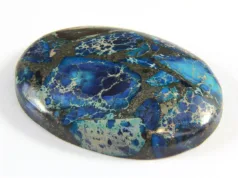Demantoid garnet is a rare and highly sought-after variety of the mineral andradite, which belongs to the garnet group. Known for its exceptional brilliance and vibrant green color, demantoid garnet gets its name from the Dutch word “demant,” meaning diamond, due to its diamond-like luster and dispersion. It is classified within the broader family of garnets, which are silicate minerals with a general chemical formula of A₃B₂(SiO₄)₃, where A and B represent different metals. Demantoid garnet, specifically, is rich in calcium and iron.
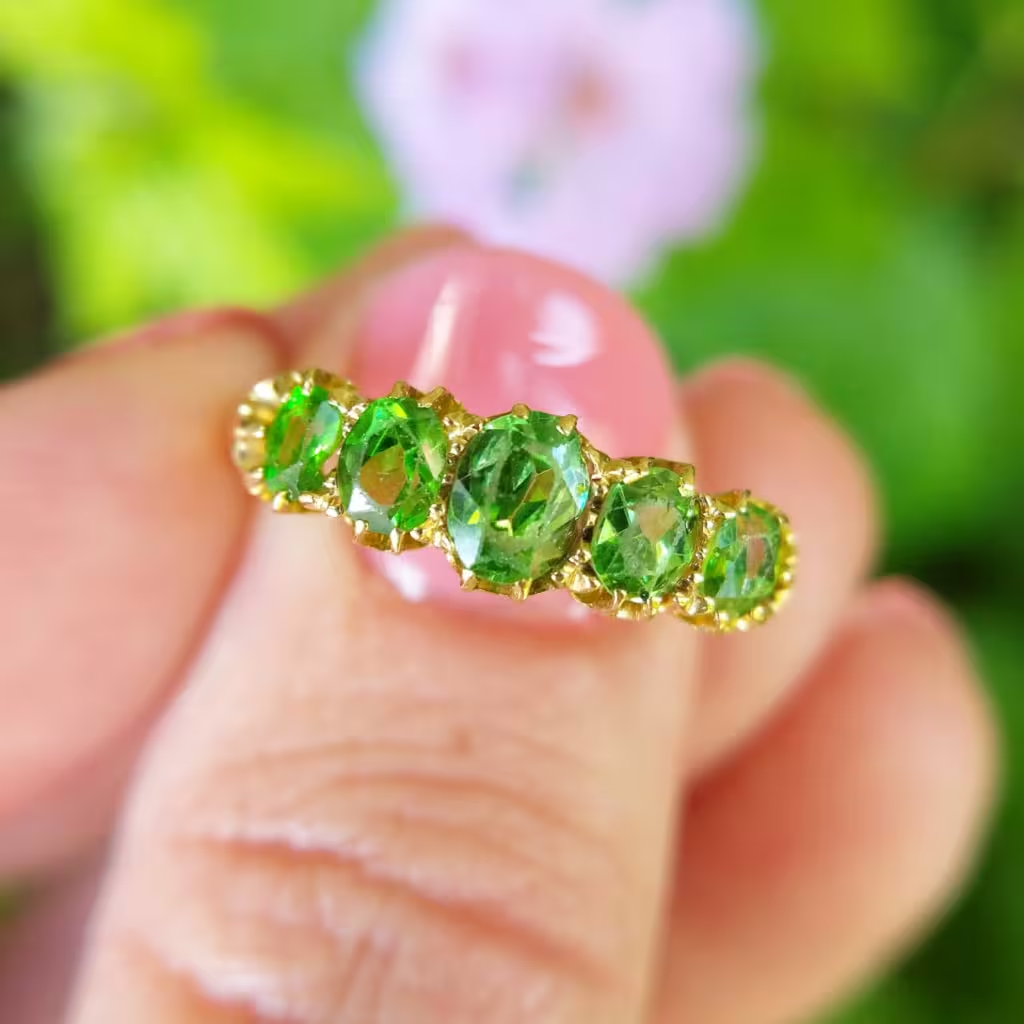
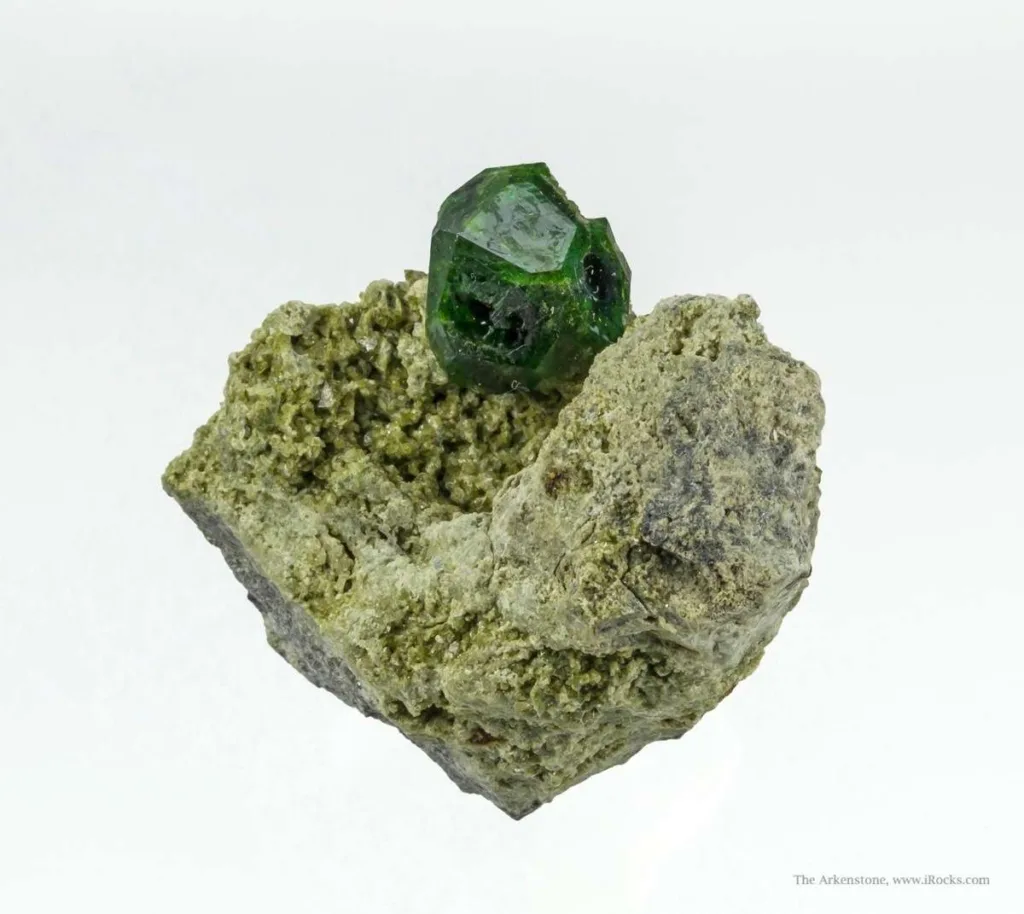


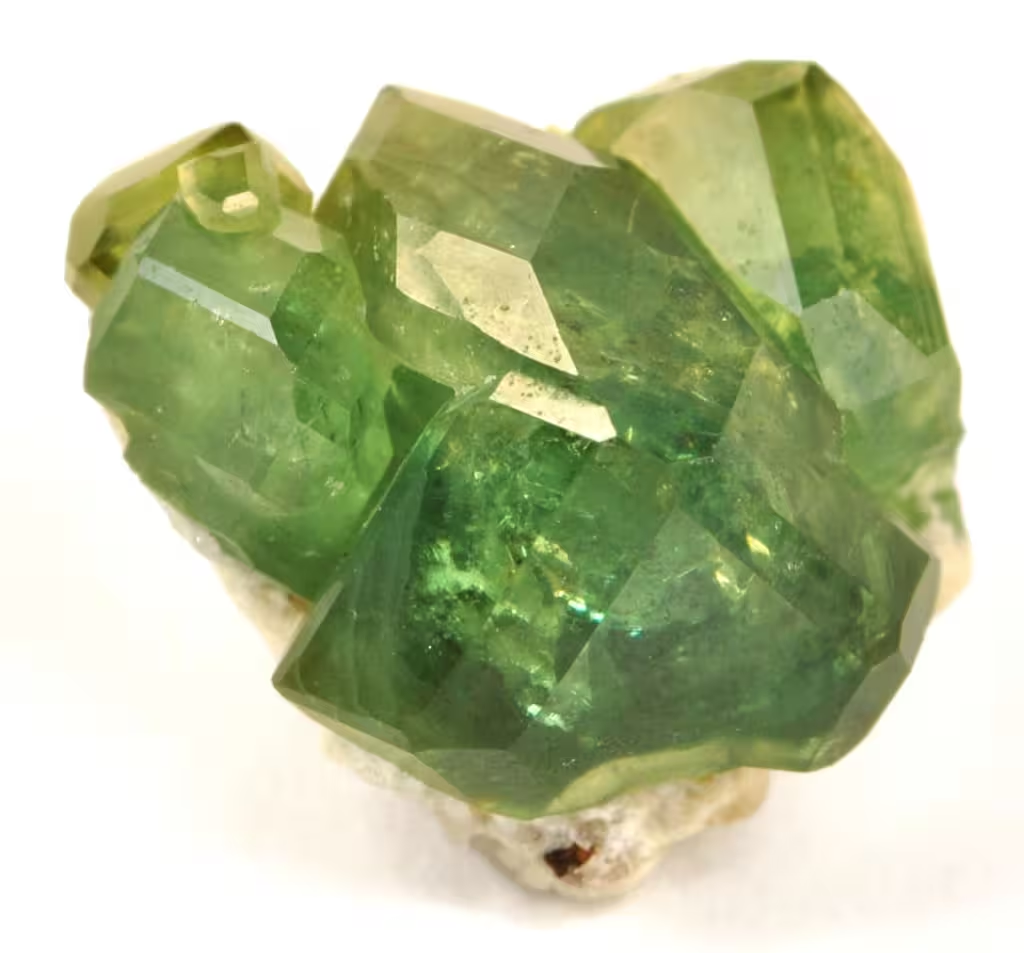
Historical Background
The discovery of demantoid garnet dates back to the mid-19th century in the Ural Mountains of Russia. It quickly gained popularity among jewelers and collectors for its remarkable brilliance and rich green hue, often rivaling the most prized emeralds. Demantoid garnet was particularly favored by Russian aristocracy and became a staple in jewelry during the late 19th and early 20th centuries. Its association with Russian royalty and exquisite craftsmanship contributed to its prestigious status in the gemstone market.
Notable Sources and Locations
The Ural Mountains of Russia remain the most famous source of demantoid garnet, known for producing stones with an intense green color and a unique inclusion called the “horsetail,” a feature highly valued by gem enthusiasts. These fibrous inclusions of byssolite are considered a hallmark of Russian demantoids. In addition to Russia, demantoid garnets have been found in various other locations, including Namibia and Madagascar. Namibian demantoids, discovered in the late 20th century, are known for their vibrant green color and high clarity, though they often lack the signature horsetail inclusions. Madagascar has also emerged as a notable source, offering stones with a range of green hues but typically lower in dispersion compared to their Russian counterparts. Other lesser-known sources include Italy and Iran, though these regions produce demantoid garnets in smaller quantities
Geological Formation and Occurrence of Demantoid Garnet
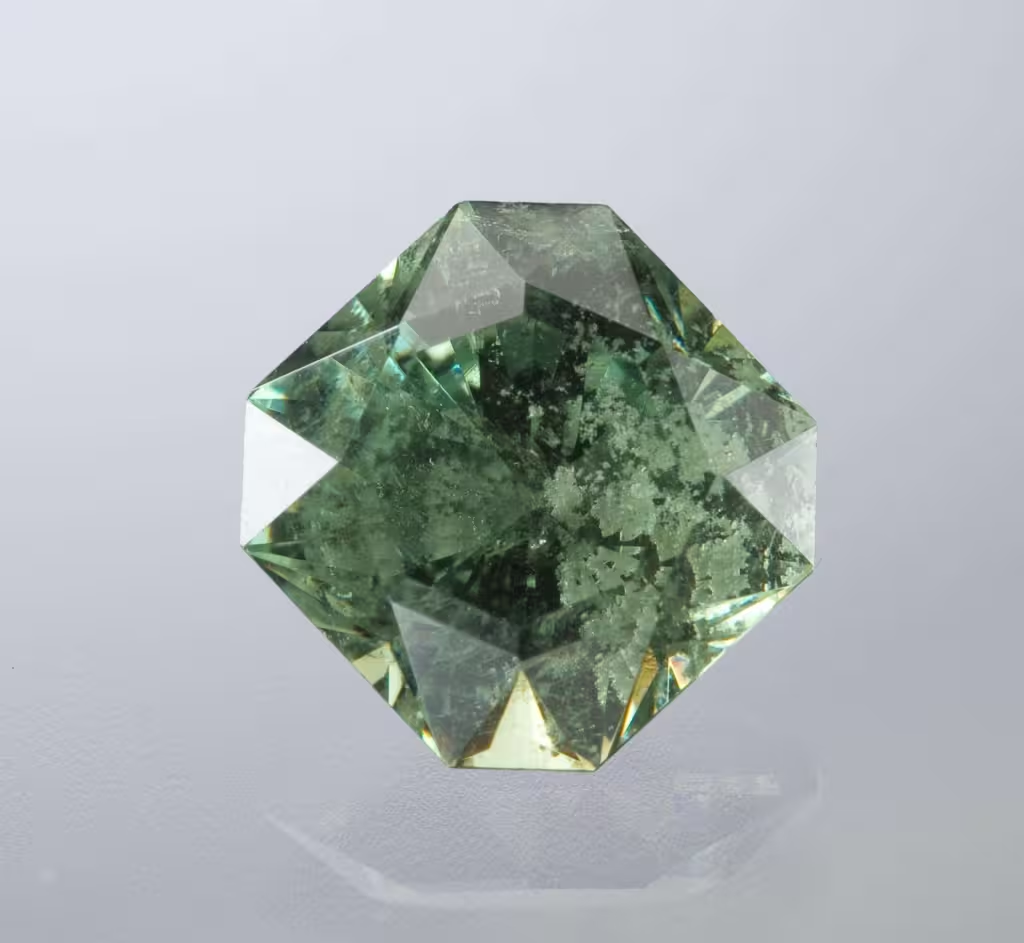
Geological Environment and Conditions for Formation
Demantoid garnet forms under specific geological conditions that involve high-temperature and high-pressure environments typically associated with metamorphic and metasomatic processes. These processes occur in regions where there is significant interaction between igneous intrusions and surrounding sedimentary or metamorphic rocks. Demantoid garnet is commonly found in skarn deposits, which are formed when carbonate rocks such as limestone are altered by the intrusion of magma. The formation of demantoid garnet requires a combination of silica, calcium, iron, and chromium, with chromium being responsible for the gem’s distinctive green color. The high dispersion and brilliance of demantoid are due to its unique crystal structure, which efficiently splits light into its spectral colors.
Key Regions and Mines
Russia (Ural Mountains): The most famous and historically significant deposits of demantoid garnet are found in the Ural Mountains of Russia. The deposits here are renowned for producing stones with the highly prized “horsetail” inclusions of byssolite. These demantoids are considered the standard of quality in the gem trade, often exhibiting a rich green color and exceptional fire. The Karkodino mine in the Ural Mountains is one of the most well-known sources.
Namibia: In the late 20th century, Namibia emerged as a significant source of demantoid garnet. Namibian demantoids are generally more vibrant in color and have higher clarity than their Russian counterparts, though they often lack the distinctive horsetail inclusions. The Green Dragon mine near the town of Erongo is one of the primary locations for demantoid garnet in Namibia. The stones from this region are highly regarded for their intense green hues and are an important contributor to the global supply of demantoid garnets.
Madagascar: Madagascar is another notable source of demantoid garnet, with deposits discovered in the late 1990s. The garnets from Madagascar vary widely in color, ranging from yellow-green to deep green. Although these stones typically have lower dispersion than those from Russia or Namibia, they still possess considerable appeal. The Antetezambato region in northern Madagascar is a key mining area for demantoid garnets. The gems from this region are often marketed as an affordable alternative to the more expensive Russian and Namibian demantoids.
Each of these regions contributes uniquely to the diversity and availability of demantoid garnets in the global gemstone market. The differences in color, clarity, and inclusions among the stones from these locations allow collectors and jewelers to select gems that best suit their preferences and needs.
Physical and Chemical Properties of Demantoid Garnet
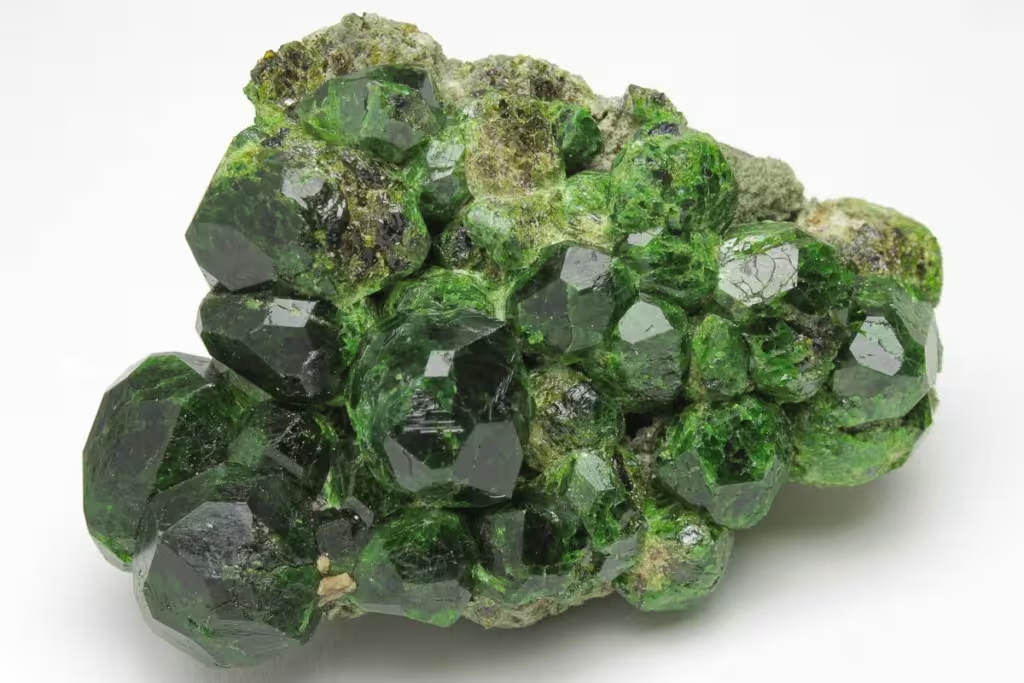
Physical Properties
- Color: Demantoid garnet is most famous for its rich green color, which ranges from yellow-green to deep emerald green. The color intensity is primarily due to the presence of chromium, and occasionally iron, within the mineral. The most prized demantoids are those with a deep, vibrant green hue.
- Luster: Demantoid garnet exhibits a high luster, often described as vitreous to adamantine, which gives the gemstone its characteristic brilliance.
- Dispersion (Fire): One of the standout features of demantoid garnet is its strong dispersion, which is the ability to split white light into its component spectral colors. This property gives demantoid its “fire,” making it comparable to diamonds in terms of brilliance.
- Hardness: On the Mohs scale of hardness, demantoid garnet ranges between 6.5 and 7.5. This makes it suitable for use in jewelry, though it is slightly softer than other gemstones like sapphire or diamond.
- Cleavage: Demantoid garnet has no cleavage, which means it does not split along specific planes when struck. This characteristic makes it more durable in certain settings compared to other gemstones with perfect cleavage.
- Fracture: The fracture of demantoid garnet is typically conchoidal, meaning it breaks with smooth, curved surfaces.
- Crystal Structure: Demantoid garnet belongs to the cubic crystal system and typically forms in dodecahedral or trapezohedral crystal habits. These crystals are often well-formed and can be found as isolated crystals or in clusters.
- Density: The specific gravity of demantoid garnet ranges from 3.82 to 3.88, which is relatively high and contributes to its substantial feel when held.
Chemical Properties
- Chemical Formula: The chemical formula for demantoid garnet is Ca₃Fe₂(SiO₄)₃, where calcium (Ca) and iron (Fe) are the primary cations, and silicon dioxide (SiO₄) forms the silicate framework. The presence of chromium (Cr) is what imparts the green color to the stone.
- Composition: Demantoid is a variety of andradite, which is a calcium-iron garnet. The presence of iron (Fe) as Fe³⁺ and traces of chromium (Cr³⁺) are crucial for the formation of its distinctive green color. Variations in the iron and chromium content can lead to differences in hue, from yellowish-green to intense green.
- Refractive Index: Demantoid garnet has a relatively high refractive index, typically ranging from 1.880 to 1.889. This high refractive index is responsible for the stone’s brilliance and its ability to exhibit a strong play of light.
- Transparency: Demantoid garnet can range from transparent to translucent. The most desirable stones are those with high transparency, as they display the most vibrant color and brilliance.
- Optical Properties: Demantoid garnet is isotropic, meaning that it has the same optical properties in all directions. This is characteristic of garnets, which are known for their even light dispersion and lack of birefringence.
These physical and chemical properties contribute to the desirability and uniqueness of demantoid garnet as a gemstone, making it a prized addition to any gem collection.
Applications and Uses of Demantoid Garnet

Jewelry
Demantoid garnet is primarily used in fine jewelry, where its brilliance and rich green color make it a highly desirable gemstone. Some of its most common applications in jewelry include:
- Rings: Demantoid garnet is often set in rings, either as a central gemstone or as accent stones surrounding a larger gem. Its durability and striking color make it an excellent choice for engagement rings and other statement pieces.
- Earrings: The high brilliance and fire of demantoid garnet make it ideal for use in earrings. It is often set in studs or drop earrings, where its ability to catch and reflect light is showcased.
- Necklaces and Pendants: Demantoid garnet’s vibrant color and clarity make it a popular choice for pendants and necklaces. When set as a focal point in a pendant, the gem’s deep green hue can be particularly eye-catching.
- Bracelets: Demantoid garnets are also used in bracelets, either in solitary settings or as part of intricate designs. Their durability makes them suitable for everyday wear, though care should still be taken due to their relative softness compared to harder stones like diamonds.
- Antique and Vintage Jewelry: Due to its historical significance and popularity in the late 19th and early 20th centuries, demantoid garnet is frequently found in antique and vintage jewelry. Pieces from this period are highly sought after by collectors and can command significant prices.
Collecting
Demantoid garnet is a favorite among gemstone collectors, particularly those who appreciate rare and unusual stones. Collectors often seek out demantoids with unique characteristics, such as the famous “horsetail” inclusions found in Russian stones. These inclusions, made of byssolite fibers, are considered a mark of authenticity and quality, and they add significant value to the gemstone.
- Specimen Collecting: In addition to faceted stones, collectors often seek out raw or minimally processed demantoid garnet crystals. These specimens can be valuable for their rarity, natural beauty, and the insights they provide into the geological processes that form garnets.
Investment
High-quality demantoid garnets, particularly those with deep green color and notable inclusions, can serve as investment stones. Due to their rarity and historical significance, well-preserved demantoids can appreciate in value over time. As demand for colored gemstones continues to grow, demantoid garnet is increasingly seen as a valuable addition to gemstone investment portfolios.
Art and Decorative Objects
While less common, demantoid garnet has been used in art and decorative objects. For example:
- Carvings: Occasionally, rough demantoid garnet crystals are carved into small sculptures or decorative objects. These pieces highlight the natural beauty of the stone and are valued for both their artistic and mineralogical significance.
- Inlay Work: Demantoid garnets may also be used in inlay work, where small stones are set into decorative patterns on objects such as boxes, brooches, and other fine art pieces.
Healing and Metaphysical Uses
In metaphysical practices, demantoid garnet is believed to have various healing properties. Some of the attributed benefits include:
- Emotional Balance: Demantoid garnet is thought to help with emotional balance and clarity, aiding in the release of negative energies and promoting a positive outlook.
- Prosperity and Success: It is often associated with prosperity and success, with some believing that wearing or carrying the stone can attract wealth and abundance.
- Physical Healing: Although not scientifically proven, some practitioners use demantoid garnet in crystal healing practices, believing it can aid in improving circulation and reducing inflammation.
Overall, demantoid garnet’s combination of beauty, rarity, and historical significance ensures its continued popularity across various applications, from fine jewelry and collecting to investment and decorative arts.



























